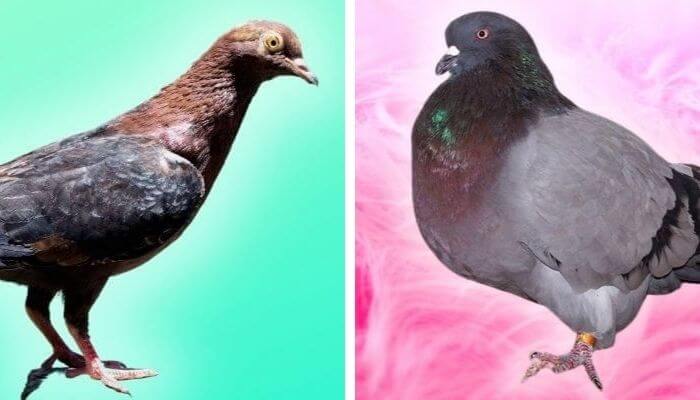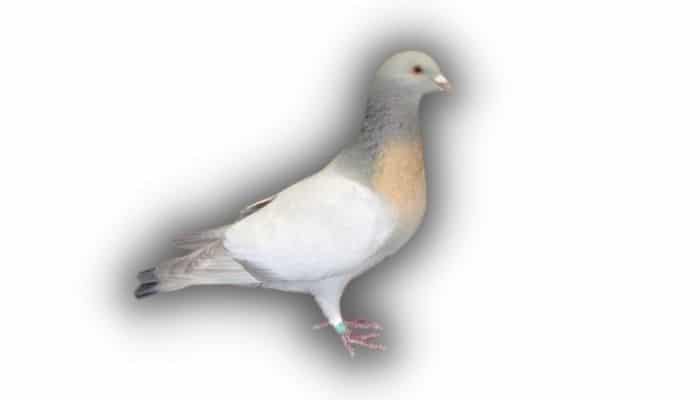Also known as the Gold Leads Lark, the Koburger Lark and the Coburg Lark Pigeon is a breed of domestic fancy pigeon that was developed over years of selective and dedicated breeding.
Origins of the Coburg Lark Pigeon
As is the story with all domestic fancy pigeons, the Coburg Lark pigeon came into existence thanks to a number of years of selective breeding by dedicated fanciers.
The Coburg Lark pigeon was originally bred in the regions of Coburg, Thuringia and Saxony in Germany, a country where so many other fancy pigeon breeds are originated.
As an Amazon Associate I earn a small fee from qualifying purchases made through Amazon links. This helps us run the site – thanks for your support!
Little is documented about its beginnings, but this breed was certainly known in the early 1800s and was included by Gottlob Neumeister in his 1876 book “Das Ganze der Taubenzucht” (The Whole World of Pigeon Breeding).
It is thought that the starter pigeon for this breed was the mealy country dove which was widely spread over the duchies Saxony-Coburg and of Saxony-Meiningen.
Neumeister suggested that the origins of the Coburg lark pigeon lie in a crossbreed of the mealy dove with archangel and runt pigeons while others have suggested Nuremberg Bagdad and the Montauban may have been involved.

It was recognised as a standard breed in 1907.
Coburg Lark Pigeon – Distribution and Habitat
The Coburg Lark pigeon is popular in Germany and has spread to other countries, especially in Eastern Europe.
Their distribution however is purely dependent on where their owners and breeders reside as they are not native to any location.
They are not an especially popular bird in the United States.
Unlike other breeds, there are no listed Coburg lark pigeon clubs in the USA or in the UK.
Habitat is domestic and as provided by the pigeon owner.
Coburg Lark Pigeon Appearance
This pigeon is a fine looking bird and is similar in appearance to the Nuremberg Lark pigeon and South German Charcoal Lark and also resembles the dove, although it is much paler in colour than all these others.
The Coburg Lark pigeon is a medium to large-sized breed standing on average 25 cm tall (10 inches).
The average body weight of a mature bird is between 650 to 800 grams (an average of 25 ounces). It is a solid looking bird with a silky sheen to its plumage.
This pigeon doesn’t have any ornamentation, so its beauty is in its overall look and colour.
It has a small narrow head that is only slightly curved and is completely light grey.

The eyes are an intense dark colour with a yellow-red iris and the cere is red.
The beak is long and straight and usually flesh coloured.
The light grey on the head graduates to a darker grey down the neck which then turns to pale bronze colour on the breast. The rest of the plumage is soft grey-ish brown.
The wings of a Coburg Lark pigeon are plain light grey to match their heads while some birds will have an interesting checkered pattern.
The wings are unusually long, close-fitting to the body and covering a good portion of the back. The long wing feathers are usually black. This pigeon’s tail graduates from dark grey to black.
Legs are pink to red and free of feathers.
The Typical Character of the Coburg Lark Pigeon
The Coburg Lark pigeon is a very active and very strong bird thanks to its medium to large size.
They have a reputation for becoming very tame in human company but that doesn’t always translate into being ‘friendly’, as it has been noted that the Coburg Lark pigeon doesn’t tend to enjoy being handled very often.
They do, however, make good pets.
They will squabble with other breeds so consider breeds carefully if you are going to have a mix of breeds in your loft.
Coburg Lark pigeons are good flyers and can cover fair distances.
Coburg Lark Pigeon Diet
Pretty much following the same diet of most fancy pigeon breeds, the Coburg lark pigeon will be happy and nourished if you fill its feeders with :
- Seed mixes
- Grain mixes
- Berries
- Nuts
- Plants
- Vegetation
- Vegetables
You should also always provide grit for pigeons.
Mating And Breeding Coburg Lark Pigeons
This breed is known for being particularly good parents.
When breeding, birds should be paired with the aim of emphasising and continuing the established physical features that are the signature of the breed.
Things like colour, patterning and size are all taken into account to try to produce the next generations of Coburg Lark pigeons that still carry the classic aesthetic and biological traits that have come to be regarded as the standard of the breed.
This breed can mate three or four times a year, producing a clutch of two eggs each time.
Taking Care of Coburg Lark Pigeons
Caring for a Coburg Lark pigeon is all about following the general instructions for pigeon and dove keeping.
Some of the most important factors of the care process to ensure a happy and healthy bird are:
- A dry home that is protected from rain, snow and wind
- A regular source of good feed
- A diet full of the vitamins a pigeon needs
- Supply of fresh water.
- A clean environment that has plenty of appropriate floor coverage, and the commitment to keeping the floor clean.
Coburg lark pigeons are best kept by those who appreciate their robust shape and unique colouring and by owners who want a tame bird that doesn’t demand much handling.
